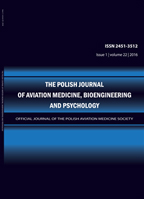2021, Volume 27, Issue 4
SELECTED PROBLEMS OF DETERMINING PILOT SURVIVAL TIME IN COLD WATER AFTER THE AIRCRAFT CRASH
PRZEMYSŁAW STĘŻALSKI1, SŁAWOMIR MICHALAK2, JERZY BOROWSKI2
-------------------------------------------------------------------------------------------------
1Armed Forces General Command
2Department of Avionics, Air Force Institute of Technology
Autor korenspondencyjny: JERZY BOROWSKI; Department of Avionics, Air Force Institute of Technology; email: jerzy.borowski@itwl.pl
Full text
Streszczenie
Survival of a pilot in an emergency catapult situation over bodies of water is an essential element for organizing a rescue operation. Also important is the ability to determine the survivability of a crash survivor in extreme conditions with prolonged immersion in cold water. This time depends on a number of factors, such as time in the water, sea condidions, water temperature, age, gender, fatigue and also biophysical parameters and predispositions of the pilot survivor. At present, the emergency services do not have the ability to determine the survival time of a pilot survivor taking into account a number of the factors mentioned. This paper presents a mathematical and simulation model of the physical phenomena of heat transfer between a pilot survivor and an extreme water environment. The physical phenomena of heat transfer were described by nonlinear and non-stationary differential equations containing important elements from the point of view of determining the survival time of a pilot survivor. The model shown is a single-segment, multi-layered and flat model of a human body. The model takes into account a number of body layers that will be cooled in the heat transfer process due to the disturbed heat balance that existed before the immersion of a pilot survivor. By assigning input parameters to the model in the form of the pilot's position, body weight, body height, water temperature, protective clothing insulation and others, information can be obtained about the dynamic processes of heat loss and body temperature drop during cooling. An important piece of information obtained from the simulation model is the visualization of the process of hypothermia of the pilot’s body and the attainment of life-threatening states. Parameters obtained from the model include time to unconsciousness and pilot’s survival time. These times can be the basis for the correct organization of rescue operations. The article presents sample plots of the pilot’s body temperature drop for various model input parameters.
Słowa kluczowe
hypothermia, rescue of a pilot survivor, mathematical model, simulation model
